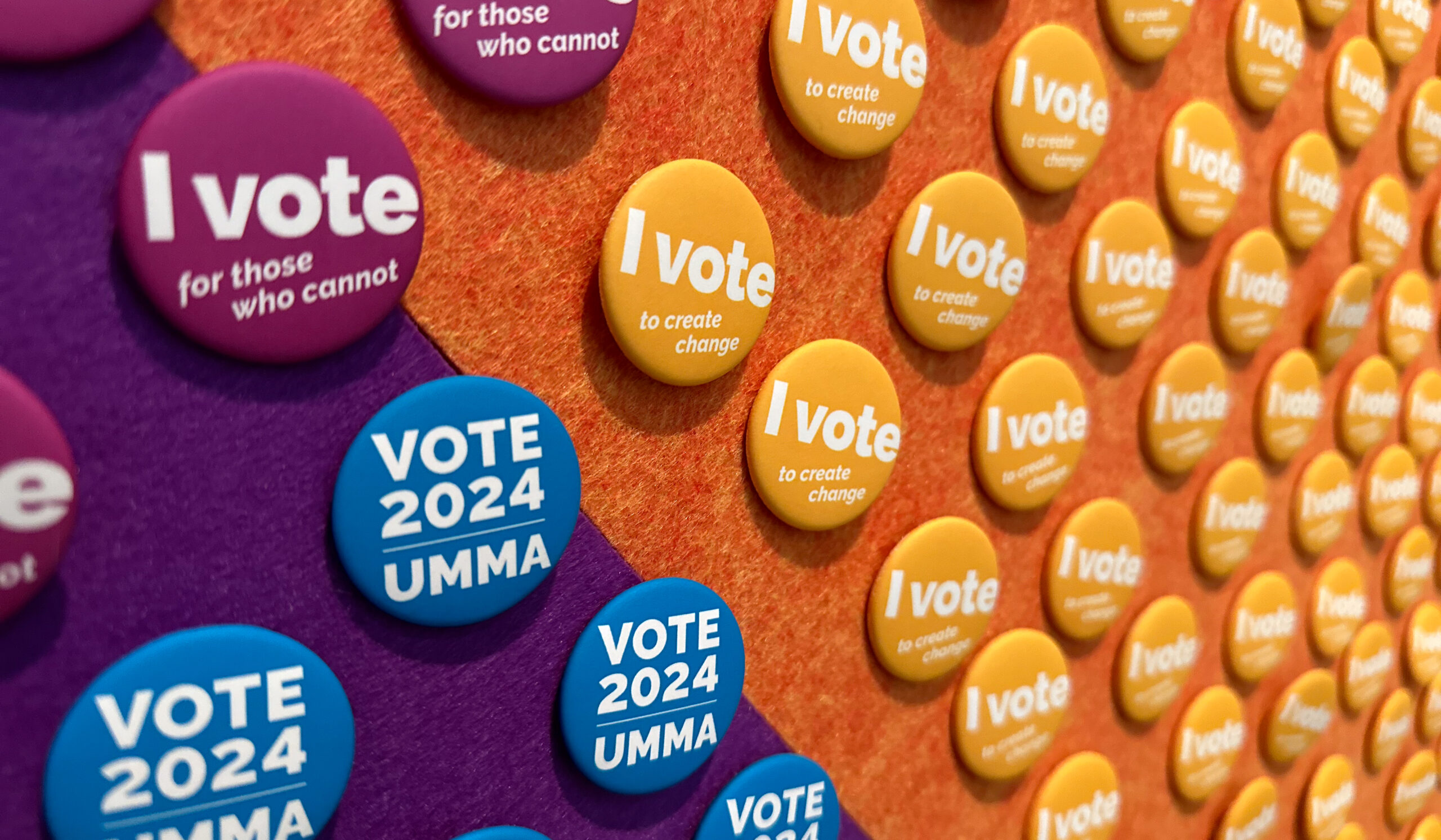The Trip to Healing
•
Illustrations by Caili Dalian
Initially introduced to the University of Michigan community as a collaborative, the Michigan Psychedelic Center, or M-PsyC, launched at Michigan Medicine in 2022 with a mission to advance multidisciplinary education, research, therapy, and community engagement related to psychedelics. The organization stretches to every corner of campus and beyond, where researchers, educators, and other professionals are studying the applications of psychedelics in medical and clinical settings.
But lingering stigmas continue to harm how psychedelics are perceived.
“It wasn’t a slam dunk, I have to admit, because there’s still a lot of baggage associated with the word ‘psychedelic,’” says George Mashour, the center’s founder and director.
Decades of anti-psychedelic political, legal, and social messaging has led to generally unfavorable public perceptions and attitudes toward psychedelic use. But Mashour acknowledges there are still lessons to take away from a historically negative perception of psychedelics.
“I think that the primary lesson from that era is that we should maintain a focus on responsibility, safety, guarded enthusiasm, and realism about the power of the psychedelic drug,” Mashour says.
Now, M-PsyC is part of a “psychedelic renaissance” in medicine, where researchers are looking to shed stereotypes and understand the healing power of psychedelics.
The Content of Consciousness
Mashour, the chair of the anesthesiology department and a neurosurgery professor at U-M, was first interested in states of consciousness — whether you are awake, asleep, or something in between the two — which led to his interest in psychedelics and how they affect the content of consciousness.
“Psychedelics are probably the best pharmacological tool to understand the content of consciousness because your level of consciousness is staying the same while your perception of the world is often radically changed. I think this is what’s really compelling to me from the scientific perspective to help us understand consciousness, to help us understand our relationship to the world,” Mashour says.
Though still developing, M-PsyC’s work includes researchers studying psychedelics and chronic pain, a clinic treating depression with ketamine, scientists exploring botanical specimens that could contain psychedelic compounds, and a new psychedelic neuroscience course offered through the neuroscience graduate program.
The center is partnering with other U-M organizations and departments, including the Chronic Pain and Fatigue Research Center, the School of Public Health, and the School of Nursing. But some partnerships stretch beyond Michigan Medicine, such as one with the Law School, which can help teams navigate the local and federal legality of psychedelic research, or the School of Music, Theatre, and Dance, where there is potential to study psychedelic music.
M-PsyC is also partnered with the Student Association for Psychedelic Studies (SAPS), an organization comprised of U-M students interested in the future of psychedelic research and applications in their varying fields. SAPS is a co-organizer of Entheofest, an annual free-speech event held on the Diag that celebrates entheogenic plants and fungi. Emma Mead, the group’s president and a graduate student in the School of Social Work, says SAPS members include students of neuroscience, business, sociology, and beyond.
“That just really opened my eyes to how many people are out there who are also interested in psychedelics not from a recreational standpoint, which is where, I think, a lot of the stigma is . . . but there’s a lot of us who are just interested in the science, in the research and want to know what else is out there,” she says.
Mashour hopes M-PsyC’s establishment as a center helps convey the legitimacy, necessity, and safety of clinical psychedelic research.
“It’s creating a home that is recognized, not just an under-the-radar, underground movement. It’s recognized by the medical school, which confers legitimacy. Ultimately, I want it to sit along with other scientific centers at the University of Michigan,” he says.
At an event last fall, Mashour shared a quote from psychotherapist Stanislav Grof, one that he believes summarizes the importance of this work: “Psychedelics, used responsibly and with proper caution, would be for psychiatry what the microscope is for biology and medicine or the telescope is for astronomy.”
Research Underway
At the U-M Ketamine Clinic, ketamine is used to help patients with treatment-resistant depression and suicidal ideations.
“You can have an impact on symptoms more quickly and beyond the presence of the drug in your body. That is what is so interesting and exciting,” Mashour says. “If you think about somebody who is acutely suicidal, or somebody who is experiencing existential distress in the setting of cancer or a dying process or palliative care, you don’t want to give a drug and say, ‘Just hang in there another five weeks.’ It’s really remarkable to have the potential to give somebody a substance and have symptoms start resolving on a faster timescale.”
Ketamine infusion therapy was developed in the 1960s by U-M researchers, who initially used the drug for sedation in procedures. Ketamine is a dissociative anesthetic, not classified as a “classical” psychedelic, and is used in more than 500 clinics across the U.S. These clinics may model future guided psychedelic treatments.
Mead is a clinical intern at Michigan Progressive Health, a ketamine clinic in Ann Arbor, and has seen the effects it has on patients.
“You can see how much that has helped some people,” she says. “Some of our clients really just, it changes their lives.”
M-PsyC’s first clinical research study is now underway. Kevin Boehnke, ’09, PhD’17, is leading the study, which is looking at fibromyalgia patients and psilocybin, the psychedelic compound in “magic” mushrooms.
Boehnke’s psychedelic research interests began with his own experiences with chronic pain and fibromyalgia. After finding that cannabis was an effective part of a greater toolkit for his chronic pain management, Boehnke worked on a study that showed how medical cannabis could improve patients’ quality of life and reduce their opioid use.
“The propaganda about cannabis being a gateway drug is untruthful except in the context of how it makes you interested in more controlled substances research,” Boehnke says.
In this new study at M-PsyC, patients take psilocybin capsules in a controlled clinical setting and work with therapists before, during, and after their experience. These therapy sessions are meant to help patients translate their experiences to engage with themselves, their greater goals, and healing.
“A lot can come up in these experiences that people have — memories, different bodily sensations, a sense of unity or fear, or any of a whole swath of emotions,” Boehnke says.
This pilot study will have 10 participants with the primary goal of demonstrating research safety while measuring participants’ sleep, anxiety, pain, thoughts about their pain, and more.
Boehnke and others are looking forward not only to what this center and research means for patients with chronic pain, but how M-PsyC and the U-M community will explore the role psychedelics can play in the future of medicine and public health.
“How does that change what our society looks like and how we think about what healing means?” Boehnke says. “M-PsyC helps provide a platform to ask some of those questions and bring a bunch of different perspectives throughout the community, throughout the institution, so that, ideally, we can think about these things as widely as possible, while also having the scientific and scholarly rigor to go really deep into each of these different areas to see how the whole picture can kind of weave together.”

Outside the Clinic
Not all work with psychedelics is clinical or research-based. Leslie Grace, ’05, ’06, left U-M with a nursing degree and planned to work as a midwife but ended up in end-of-life care. Now, she’s a psychedelic guide that helps people work toward goals or through traumas with psychedelic journeys and integration sessions.
“I got to see the underbelly of the medical system and medical model that leaves a lot of people high and dry, medicating the symptoms, but really not addressing the underlying causes of a lot of psychological issues,” she says.
Grace’s first personal psychedelic experience was in 2009 with ayahuasca, a plant-based psychedelic brew traditionally used by Indigenous cultures in South America.
“I had a Kundalini awakening, which is like an energetic opening in my body that was deeply profound,” she says.
Grace became a sex and intimacy coach, working with individuals and couples on sexual healing work. She did a two-year somatic psychotherapy training and another private training to become a psychedelic guide and now primarily supports people who are using psilocybin or MDMA, a synthetic psychedelic also known as ecstasy. She has 15 years of experience in intentional psychedelic exploration and helps people experience and understand expanded states of consciousness with psychedelics.
“Most people kind of spend all of their energy sort of avoiding going to those deep, tender, emotional places because they’re painful,” Grace says. “But the whole point of this is to kind of get the mind’s defense mechanism out of the way so you can actually drop into the body, drop into emotions, and let them move and shift.”
Some people come to her to heal from traumatic or abusive past experiences. Others are looking to ease a nagging restlessness, express their sexuality, or explore spirituality. Grace also works with executives and people in tech leadership who have found career success but struggle with personal relationships, a “deep-rooted sense of not enoughness,” or who are seeking a greater purpose in life.
Grace may spend hours counseling with a person, physically hold them, get them what they need, and do whatever else is necessary to support someone’s psychedelic experience and help them reach their previously discussed goals. Similar to clinical settings, she uses integration sessions to help people work through what happened during the journey.
“Integration is the hardest part for a lot of people. It’s how do we make it real, how do we actually live into these insights? How do I let it land in my being as what’s really here, what’s really true?” she says.
For Grace, psychedelics are not about symptom management.
“This is about really getting down to what’s real and true about us in the deepest ways and having the most fulfilled version of your life that really gets to be about making yourself whole and well and then serve humanity, serve others,” she says. “This is about the much, much bigger picture.”

On the Horizon
Researchers say psychedelics’ integration into mainstream medical and recreational use may follow a similar trajectory as cannabis in the U.S.
“Cannabis and psychedelics are not going anywhere. And the best way to understand them, and work with them, is to engage in all these different ways, be they scientifically, be they through educational outreach, be they clinically. And that’s what we’re doing in the center,” Boehnke says.
Many also want to see psychedelics’ accessibility expand.
“At the end of the day, this can’t just be for the believers, who are really jazzed by psychedelics and can afford to engage with them. We need to build a rock solid, impeccably credible foundation of knowledge that can be convincing to anyone, any physician who might be skeptical or a patient. And this needs to be made more accessible,” Mashour says.
No matter their level of experience, research background, or excitement, leaders in the psychedelic space emphasize the importance of safety.
“Enthusiasm is warranted,” Mashour says. “But it has to be constrained by the guardrails of safety, ethics, rigor, and responsibility.”
Katherine Fiorillo is the editor of Michigan Alum.



